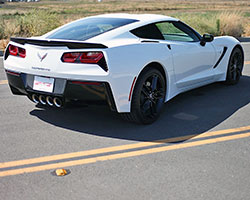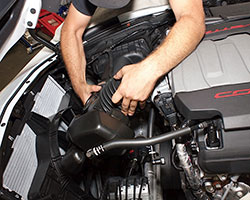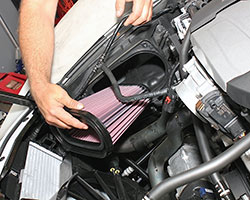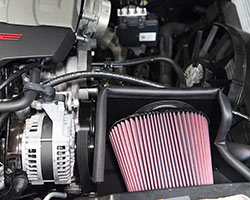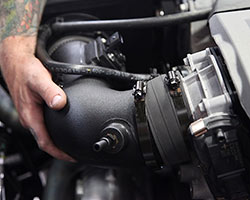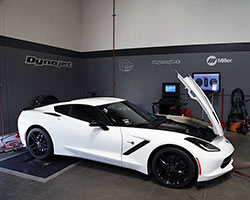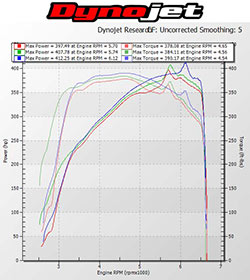Corvette Online Project C700: C7 Stingray Gets Dyno Proven Power Gains From K&N Filter & Intake
- Oct 22, 2015
Corvette Online is a leading digital magazine dedicated to America’s Sports Car, the Chevrolet Corvette. Corvette Online caters to all generations of GM’s flagship performance car with news, car features, and in-depth technical content. When deciding which performance modification to perform first to the Corvette Online Project C700 2015 Chevy Corvette Stingray Z51, Corvette Online sought the superior airflow and superior performance K&N is known for. Brent Davis of Corvette Online wrote, “To this point, we have been beyond pleased with the performance, drivability, sound, and handling of the Stingray. However, we can never seem to leave well enough alone, and as such we have officially kicked off the path which will hopefully allow us to fulfill the goal of this build, and thus proving worthy of its name...producing 700 HP.” Despite industry leading performance, the 2014-2016 Corvette is equipped with a low-tech disposable air filter inside the air box. However, K&N high-flow stock replacement air filter E-0665 is designed to inject high-flow technology into the 2014, 2015, & 2016 Chevy Corvette. While Corvette Online was ultimately more interested in running the K&N 2014-2015 Corvette intake system 63-3081, they decided to first see how the standard replacement air filter could improve performance.
After installing the K&N 2014-2016 Chevy Corvette 6.2L V8 replacement air filter, Corvette Online strapped the otherwise stock Stingray to their in-house Dynojet dynamometer. As Brent Davis wrote, “You may just be as pleasantly surprised as we were.” Brent continued, “With that simple and very inexpensive change, our stingray produced 407.7 HP and 384.1 lb-ft of torque. This is an increase over stock of 10.3 horsepower and 6.1 lb-ft of torque to the rear wheels, which is really quite impressive.” Corvette Online gave their 2015 Z51 Stingray some time to cool down following the dyno passes with a K&N air filter before moving on to the complete K&N air intake system install. Brent Davis wrote in his online article, “The installation was very simple and straight forward. The job only takes a few simple hand tools and the supplied instructions to make it a walk in the park. This procedure is best completed in the comfort of a garage, but if a driveway or parking spot is all you have, fear not; you will be back on the road in no time and reaping the benefits of your new (K&N) air intake system.”
When Corvette Online strapped their 2015 Chevy Corvette Stingray Z51 6.2L V8, with an 8-speed automatic transmission, to their dyno in stock trim the car produced 397.4 HP and 378.0 lb-ft of torque. As mentioned earlier dyno testing with a K&N stock replacement air filter showed gains of over 10 HP and 6 lb-ft of torque. But for Corvette Online it was now time to see if K&N was able to live up to its estimated additional power increase of 12.51 horsepower. The results of the dyno test with K&N air intake 63-3081 “showed that with the full K&N system in place, our LT1 pushed out 412.2 HP and 390.1 lb-ft of torque. Overall, this modification gave us an increase of 14.8 HP and 12.1 lb-ft of torque compared to our stock base run,” wrote Brent. In his online article he continued, “We are happy that we outperformed the results claimed by K&N, as they said you can expect a gain of 12.51 horsepower.” Brent also wrote, “The dyno graph shown here also depicts an important aspect we like to look at, which is known as the power under the curve. Simply put, this means that while peak numbers are great, there is more to it than that.”
Looking at the Dynojet dyno chart from Corvette Online, the drop-in K&N replacement air filter increased performance slightly, but almost follows the stock dyno curve contour. However, K&N air intake 63-3081 was able to effectively reshape the power curve a bit. Brent wrote, “The torque curve flattens out at a lower, more usable, RPM and stays there longer, while the horsepower curve moved up in the RPM range yet produces in excess of 375 HP for a much longer period.” Probably more important than dyno graph numbers and horsepower claims is how a vehicle drives on the road. Brent wrote in the Corvette Online article, “When you are starting out with such a large amount of horsepower, it makes more substantial gains to really notice a difference from the driver’s seat. While the car may not “feel” a whole lot faster, we definitely felt a difference pulling through some of the taller gears. The LT1 no longer sounds starved for air and its throttle response is noticeably improved. We couldn’t be happier with our results and to report positive power numbers with either choice.” Please use the search by vehicle tool to find all K&N products and air intakes for your Chevy Corvette, or for another vehicle. Use the K&N Dealer Search to find an authorized K&N dealer in almost any part of the world. |
||||||||
|
||||||||

